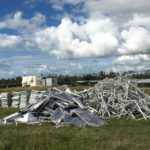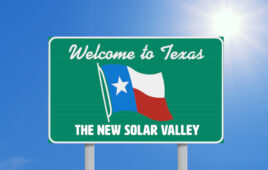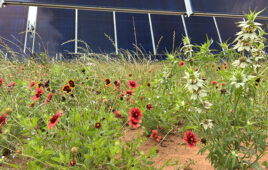By Manish Nayar, CEO, OYA Solar
The polar vortex blew some frigidly cold weather into the U.S. last week. It also brought out some confused comments about solar in cold weather like this one:
It’s a bit cold outside this morning in middle America… Aren’t you glad you aren’t heating your home with a solar panel like nitwit Socialist @AOC is demanding? pic.twitter.com/7080xSEPuC
— Jim Hoft (@gatewaypundit) January 30, 2019
This wasn’t the only comment like this I saw. Tucker Carlson made a similar point and countless other similarly wrong comments popped up on my (and I’m sure your) Facebook and Twitter feeds. I’ll set aside the political commentary here, but as a solar company that was founded in Canada and is developing projects in cold weather states such as Minnesota, New York and Massachusetts, I felt the need to dispel any myths about solar not working in cold weather — even sub-zero cold weather like we saw last week.
First, a solar photovoltaic (PV) panel creates energy from the sun’s radiation (light) not the sun’s heat. A PV solar panel is made up of a layer of silicon cells and when light interacts with a silicon cell, it causes electrons to be set into motion, which initiates a flow of electric current.
As long as the sun is hitting a solar panel, the solar panel will generate electricity — no matter how cold it is. In fact, PV solar works most efficiently in colder temperatures. A cold, sunny environment is the optimal operating condition for solar panels. Counterintuitively, it’s heat that actually reduces solar efficiency. Lab tests have shown that panels start to lose efficiency above 77ºF.
This is why, for example, solar is a critical source of power at McMurdo Station, the primary hub for U.S. science operations on Antarctica. I won’t even get into the temperatures in outer space, where solar powers the International Space Station, but suffice it to say those panels experience temperatures that are significantly colder than even Canada during a polar vortex.
In fact, the solar industry is thriving in cold-weather states. Minnesota ranked 16th in solar jobs nationwide in 2017 according to the Solar Foundation’s “Solar Jobs Census,” and Massachusetts, Vermont and New York all have large, vibrant solar markets too.
This isn’t to say that solar isn’t more challenging in northern latitudes. Solar PV plants in these locations will have lower capacity factors — meaning each panel will produce less energy over the course of a year — than solar farms in the Sun Belt. Shorter days in winter, snow cover, clouds and a lower angle of the sun can all reduce the amount of sunlight solar panels can harvest.
Additionally, construction of solar farms needs to be scheduled more tightly in colder climates due to shorter construction seasons. The farmers and landowners whose land we often lease for solar projects understand these constraints since they are similar to what they also plan around in their growing season.
Finally, profit margins for solar arrays are tighter in northern regions, making engineering expertise, system design and siting even more critical. But solar costs have dropped so dramatically over the last decade that there is no issue with making solar work in these regions.
Much more important than a region or state’s temperature in making solar viable is ensuring strong local and state solar policies. With tighter margins in cold-weather states, creating the right policy framework is critical. One example of a robust solar policy for cold-weather states is community solar. Community solar refers to local solar facilities shared by multiple community subscribers who receive credit on their electricity bills for their share of the power produced. It works in places like Minnesota because it works for anyone with an electric bill, including renters, residents in multi-unit buildings, municipalities, non-profits and businesses that don’t own their roofs.
As solar continues to grow across North America, I hope more and more people take time to understand how the technology actually works. The good news is you don’t need an engineering degree to understand that solar panels turn sunlight into energy even in the most frigid weather.









Solar has nothing to do with temperature & everything to do with the sun. I hear comments about them not working in winter but if you read or listen carefully, the people making those comments never own Solar Panels, They know a friend of friend or there is a solar farm across the street.
Tucker Carlson thought a comic about Capt.America fighting Marvel’s version of the KKK was a bad thing. Do we really taking his advice on solar panels?
I think Bob and Donald make some excellent points regarding the problem with solar panels when covered with snow and ice. It’s part of the reason that those in the power industry refer to wind and solar as “unreliables”, not renewables.
With cold comes snow, ice, sleet and the like. Here in Minnesota we experience it all, from blasting sunshine to blizzards. Although solar cells have a purpose, and contribute to the grid, they only product when the sun is up, and when the cells are not covered with snow, ice and the like. I have two major solar farms close to me in southern Minnesota. Both have been covered with snow for weeks, and are producing little to no electricity, day or night. They have no snow removal system, no person has bothered to clear the panels, and the panels do not clear themselves, especially when the temperature is low enough to keep snow and ice sufficiently Frozen on the panel. Given this, the grid is not benefiting from this solar farm, and all our electricity comes from coal, natural gas or nuclear, we have almost no hydro power in Minnesota. Also, since there is no viable way to store electricity on the grid, even if the solar panels are producing at full capacity, we would have to consume all the power produced at the time it is generated. The only benefit is that it reduces the load on fossil fuel generators, which can reduce fossil fuel consumption. Either way, Minnesota consumes electricity mainly generated from fossil fuels, solar is a small contributor, when it can generate. This will be hard to change, even if a viable storage method is developed.
Hey Bob, I have skylights in my ski cabin and I can’t remember a time when there was enough snow to block out the sun even with several inches on snow on top. Usually it sheds before it shades. Same thing with solar panels. Do you have the actual production data to prove your statement that they are not producing electricity simply because they have snow on them? Obviously they are producing less than they do in summer because the days are shorter but covered with snow may be less of a factor than you imagine.
Solar is more efficient in colder weather do some research before you speak
Intresting.
Actually, solar panels produce more, on cold days
Just wish I had the opportunity to lease out land for a solar farm. I have land within half mile of a substation.
Another great article Solar Power World and Manish Nayar. Quest Renewables has many solar canopy installations in the snowy Northeast.
When in doubt read the technical data sheet…. I trust a video version is available for those incapable of obtaining information from documentation
When they are covered with 12+” of snow how well do they perform?
This commentary is about cold, not snow.
I will agree with you that the commentary… IN THIS ARTICLE… is about cold and not snow. The question is, did the author of THIS ARTICLE correctly or incorrectly assume that the author of the original statement was specifically referring to the efficiency of solar panels due to temperature? Since he (Jim Holt) said nothing about solar not working or even not working as efficiently, specifically due to the cold temperature, it is a valid question. When your posts are limited to however many characters that twitter limits you to, you sometimes have to give a ‘Readers Digest condensed version’ and it doesn’t always convey your intended message thoroughly enough for everyone to completely understand your intended meaning. If you are going to accurately interpret (nitpick?) exactly what the author wrote, let’s look at exactly what he wrote.
“It’s a bit cold outside this morning in middle America… Aren’t you glad you aren’t heating your home with a solar panel like nitwit Socialist @AOC. is demanding?”
That’s it.
He mentioned it being cold, the graphic was of the recent below zero temperatures in Chicago, he was referring to heating a house and mentioned AOC (who wants fossil fuels to be eliminated). Nothing was mentioned about a solar power source not working, or even being less efficient, specifically due to the cold temperatures. There are plenty of reasons that relying on solar panels as the sole source of energy to heat a home where it gets seriously cold is not a good idea. If your connection to the power company is lost, what are you going to do? Some would have fireplaces, but most of those fireplaces would not be able to heat the house anywhere near as well.
The South side of my roof is full of solar panels and there are some more on the West side. I am familiar with solar photovoltaic systems. I am also fully aware that, all else being equal, solar power is more efficient in cold weather than in hot weather. The key phrase is ‘all else being equal’. The problem is that when you get far enough North to where that white stuff comes down from the sky… and stays for a significant amount of time… all else is usually not equal during this time of year.
The author of this article stated “As long as the sun is hitting a solar panel, the solar panel will generate electricity— no matter how cold it is.” This is a pretty simplistic statement and ignores examples of how all is not equal. I really wouldn’t want to have to clean the snow off my panels every time it decided to snow. If you don’t clean it off, the sun won’t hit the panels. After you clean off the panels, then sun can hit your panels. It doesn’t take much as far as spots of snow, however, to noticeably degrade your output. I have seen the evidence on the app for my microinverters of how a few leaves sticking up on my neighbor’s bush/tree/whatever-it-is can decrease the output of a panel. What other ‘not equal, examples are up there?… What is the angle to the sun from the panel? How long is the day from sunrise to sunset? How many more trees or structures now block the sun since it is lower on the horizon? How much cloud cover is there? All of these factors regularly get worse during the winter. Then you would often have to worry about the possibility of losing your connection to the power company unless you have enough batteries to last you until your power is reconnected.
How well would you perform when covered with 12+” inches of snow?
Could it be possible that they were referring to the cold weather repudiating (in their minds) global warming and hence no need for alternative, less carbon intensive energy?
Great article, thanks for dispelling the myth that power comes from heat!
I’m having an assessment done to install solar power at our mid-Minnesota home. I was glad to hear solar installations are on the rise in MN.